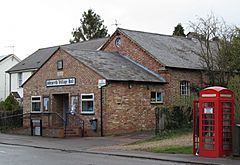Shepreth facts for kids
Quick facts for kids Shepreth |
|
|---|---|
 Shepreth Village Hall and Shepreth Book Exchange, converted from a red telephone box |
|
| Population | 819 (2001) 768 (2011 |
| OS grid reference | TL3947 |
| District |
|
| Shire county | |
| Region | |
| Country | England |
| Sovereign state | United Kingdom |
| Post town | ROYSTON |
| Postcode district | SG8 |
| Dialling code | 01763 |
| Police | Cambridgeshire |
| Fire | Cambridgeshire |
| Ambulance | East of England |
| EU Parliament | East of England |
Shepreth is a small village and civil parish in South Cambridgeshire, England. It is located about halfway between the cities of Cambridge and Royston.
Contents
Discovering Shepreth's Past
Shepreth parish covers an area of 1318 acres. It is bordered by the River Rhee to the north and other streams to the east and west. To the south, it shares a border with the parish of Fowlmere.
Ancient History of Shepreth
People have lived in the Shepreth area for a very long time. Stone Age weapons and tools have been found here, suggesting that early humans might have lived near a lake in what was once a marshy area. Evidence of Roman homes has also been found in the drier parts of the parish.
The village also has two medieval sites with moats, which are protected as ancient monuments. These moated sites show how people lived and defended their homes many centuries ago.
What's in a Name? The Meaning of Shepreth
The name "Shepreth" comes from old words meaning "sheep stream." In the past, this stream was a special place where sheep could be washed. This happened as they traveled on their way to Cambridge. A bridge called the Sheep Bridge was still in use in 1626.
Who Owned the Land? Shepreth's Manor History
Before the dissolution of the monasteries (when monasteries were closed down), the land in Shepreth was owned by the Abbey of Chatteris. Later, it passed to important people like Sir William Laxton and his family.
Other parts of Shepreth, known as the manors of Docwras and Wimbish, were once owned by Geoffrey de Mandeville. They then belonged to the Hospital of St. John of Jerusalem. After the monasteries closed, these lands were owned by William de la Haye and his family.
Shepreth's Churches and Memorials
The main church in Shepreth is called All Saints. It is a very old building made of brick and flint, built in the Early English style. It has a nave (the main part of the church) and a short tower with two bells.
Inside All Saints Church
The arch leading to the chancel (the area around the altar) dates back to the early 12th century. Inside, you can find memorials to the Layer family from the 1700s. There is also an octagonal font (a basin for baptisms) from the 13th century, made of Barnack stone. An old oak treasure chest was found in the church around 1895.
The church is a grade II* listed building, meaning it is very important historically. It was repaired in 1870 and can seat 120 people. Records for the church go all the way back to 1569.
Other Places of Worship and Remembrance
Shepreth also has a Congregational chapel, which was built in 1901 and can seat 120 people. In 1920, a stone cross was put up at Pretty Corner. This cross remembers the men from the parish who lost their lives in World War I.
Life in Shepreth Village
Shepreth has been connected to the wider world by its own railway station since 1851. In 1849, the Royston and Hitchin Railway Company paid money to the village to build the railway across Shepreth L-Moor.
Shepreth Railway Station
Shepreth railway station is on the Great Northern Line. This is a major railway line that connects Cambridge and London. The station makes it easy for people to travel to and from the village.
Nature and Research in Shepreth
The parish is home to a wildlife park, where you can see many different animals. There is also a nature reserve, which protects local plants and animals. Shepreth L-Moor is a common area that villagers can use. The village also has the UK's only insect research laboratories, where scientists study insects.
Village Pubs and Social Spots
Shepreth has two public houses, which are often called pubs. These are The Green Man, located at Frog End on the road to Cambridge and Royston, and The Plough on the High Street. In the 1700s, The Green Man was known by a different name, the Bottle and Anchor.
The building that is now The Plough burned down and was rebuilt in 1896. Another pub, The Railway Tavern, opened near the station in 1873 but closed around 1960.
Images for kids
-
Keeper with barn owl (Shepreth Wildlife Park)
-
Capybara in Shepreth Wildlife Park
-
Mandarin duck in Shepreth Wildlife Park
-
Dartmoor pony in Shepreth Wildlife Park
-
alpacas in Shepreth Wildlife Park
See also
 In Spanish: Shepreth para niños
In Spanish: Shepreth para niños










